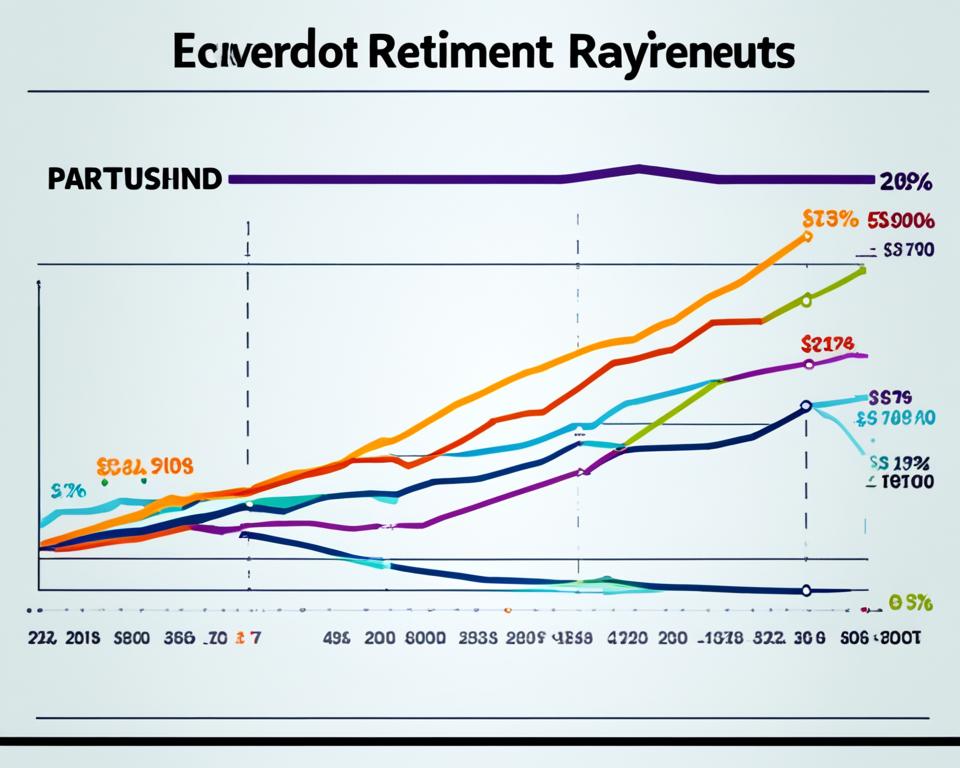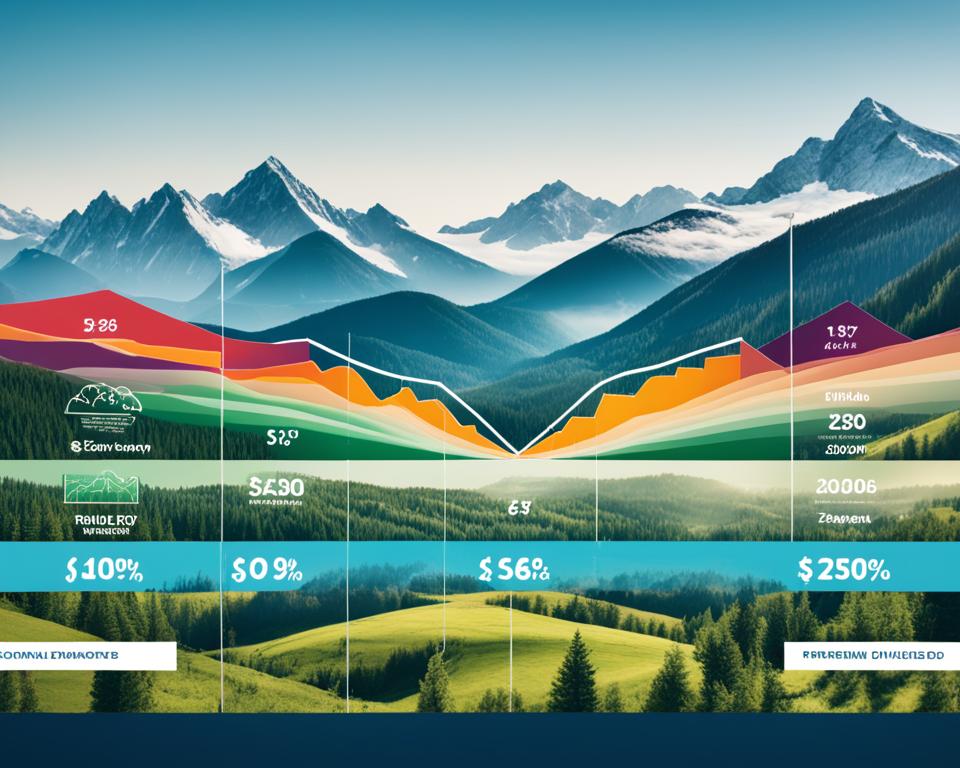Dividend-focused investors are often faced with the challenge of managing taxes in their portfolios—especially when dividends serve as a vital income source. Still, what if there were strategies to shield these gains from sizable tax reductions? The practice of tax-efficient investing offers solutions. Each investment decision, particularly concerning dividends, can have substantial tax implications. Consequently, investors need to focus on investing in assets congruent with tax-minimization strategies as part of efficient dividend portfolio tax planning.
Managing tax exposure within the framework of a dividend portfolio involves understanding the varying tax rates associated with different dividend classifications. For instance, dividends accrued in taxable accounts can be subject to either ordinary income rates or qualified dividend rates. There’s a tax advantage to be gained by leveraging accounts such as 401(K)s or IRAs, which can defer or completely eliminate immediate taxable events, thus allowing for tax-efficient growth of investments.
Besides optimizing through the use of tax-advantaged accounts, savvy investors can employ strategic moves such as tax-loss harvesting. This strategy involves offsetting taxable gains by selling securities that have experienced a loss—an approach that plays a significant role in the overall tax optimization for dividends. Therefore, staying updated on all tax factors related to investment decisions is imperative for investors keen on preserving and growing their wealth.
Key Takeaways:
- Familiarize yourself with the tax implications of your investment decisions, particularly those related to dividends.
- Consider investing in assets that correspond with tax-minimization strategies for efficient dividend portfolio tax planning.
- Make use of tax-advantaged accounts like 401(K)s or IRAs to potentially defer or avoid immediate taxable events.
- Understand the difference in tax rates for ordinary and qualified dividends to maximize returns.
- Leverage strategic tax moves such as tax-loss harvesting to offset taxable gains and optimize your tax situation.
The Role of Tax-Advantaged Accounts in Dividend Portfolios
As you navigate the investment landscape, understanding tax rules for different types of income is a critical factor in your financial success. Specifically for dividend investors, identifying methods to limit exposure to dividend taxation can help you engage in tax-smart dividend management to substantially increase your after-tax returns. In the pursuit of maximizing retained earnings from investments, tax-advantaged accounts hold a significant place.
Understanding Qualified vs. Ordinary Dividends
Dividends generally fall into two categories – regular or ordinary, and qualified. The tax treatment of these dividends is a key area where investors can minimize taxes on dividends. Regular dividends are taxed as ordinary income, corresponding with the taxable income of an individual and potentially placing them in a higher tax bracket. On the other hand, qualified dividends offer an advantage with their lower tax rates, equivalent to capital gains instead of traditional income.
Why Retirement Accounts Can Shield You from Tax
Utilizing retirement accounts such as Roth IRAs serves as a shield against immediate tax exposure on dividend income. Such accounts allow dividend investors to defer tax obligations until funds are withdrawn during retirement, and in the case of Roth accounts, taxes can be potentially avoided altogether. This kind of deferral can help protect your investment growth from the immediate burden of taxes.
Strategic Placement of Assets to Manage Taxes
Last but not least, the strategic placement of assets is a vital component of tax-smart dividend management. By tactically housing dividend-paying investments and focusing on qualified dividends within your retirement accounts, you can effectively manage tax impacts. This careful selection and strategic location of assets play a crucial role in managing dividend taxation.
In conclusion, for those seeking to minimize taxes on dividends, understanding the types of dividends, utilizing tax-advantaged accounts, and strategically placing assets can help achieve a more effective approach to tax management in your investment journey.
Managing Taxes Through Qualified Dividend Selection
The art of managing taxes in a dividend portfolio is heavily influenced by a careful selection of qualified dividends. By focusing on qualified dividends, investors unlock the benefits of lower tax rates associated with these dividends. To categorize a dividend as ‘qualified,’ there are specific pre-requisites that must be met. Firstly, the stocks must be held for a predetermined duration, and secondly, the dividend must be issued by a corporation that is either based in the U.S or a qualifying foreign corporation.
For investors who fall into higher tax brackets, for instance, the 35% bracket, a significant difference in tax liability can be observed when comparing qualified dividends which are taxed at 15%, and ordinary dividends which are taxed at the same rate as their regular income.
For a clearer understanding, let’s look at the potential tax savings an investor could achieve by selecting qualified dividends as opposed to ordinary dividends:
| Tax Bracket | Ordinary Dividend Tax Liability ($) | Qualified Dividend Tax Liability ($) | Potential Tax Savings ($) |
|---|---|---|---|
| 35% | 350 | 150 | 200 |
As evident in the table, the potential tax savings for an investor in the 35% tax bracket selecting qualified dividends could amount to $200.
The tax savings alone make focusing on qualified dividend selection a fundamental aspect of tax-efficient investing. Therefore, it’s one of the crucial dividend tax strategies for optimizing after-tax returns.
Reinvestment Strategies to Maximize After-Tax Returns
Investors looking to enhance their after-tax returns often turn to reinvestment strategies. By concentrating on optimizing their reinvestments, they can navigate the tax implications of dividends and potentially achieve better portfolio performance. Key to this is developing an understanding of the effects of Dividend Reinvestment Plans (DRIPs) and other automatic reinvestment options on their tax obligations.
The Implications of Dividend Reinvestment Plans (DRIPs) on Taxes
Offering a way for investors to automatically reinvest their dividends into additional shares, DRIPs come with their own set of tax implications. For starters, it’s important to note that even though DRIPs do not provide immediate cash payouts, reinvested dividends are still treated as taxable income.
Receiving dividends in the form of additional shares can defer the tax liability until the sale of those additional shares. However, choosing dividends in stock over cash does not negate the occurrence of a tax event. This often-cited misconception can lead to unwelcome surprises come tax season.
How Automatic Reinvestment Impacts Your Tax Bill
Similar to DRIPs, automatic reinvestment options have a direct impact on tax bills. Dividends that are automatically reinvested are treated as taxable income, regardless of their method of distribution. The tax event is triggered once the dividends are paid, even if they’re paid in the form of additional shares and not actual cash. Understanding these aspects is critical to making smart tax choices, minimizing taxes on dividends, and maximizing after-tax returns.
However, the greatest advantage of automatic reinvestment, particularly with DRIPs, lies in the opportunity they afford for compounded growth. Over the long term, the reinvested dividends contribute to purchasing more shares, which in turn generate their own dividends, thereby setting off a cycle of potentially exponential growth in the investor’s holdings.
| Reinvestment Strategy | Immediate Cash Payout | Creates Tax Event | Potential for Growth |
|---|---|---|---|
| Dividend Reinvestment Plans (DRIPs) | No | Yes | High |
| Automatic Reinvestment | Varies | Yes | High |
With careful planning and an understanding of the tax implications of dividends, investors can use these reinvestment strategies to bolster their portfolios and promote robust growth over time.
Understanding the Dividend Tax Rate: Strategies for Tax Minimization
The tax situation surrounding dividends is an intricate element of investing, with the potential to considerably impact the net returns for investors. This draws attention to the significance of the dividend tax rate that applies to income from investments. Be it unqualified or qualified dividends, the tax treatment varies and largely dictates the amount taken home after taxes.

Bracket Management: Staying within Lower Tax Rates
Unqualified dividends are taxed at the investor’s regular income tax rate. This effectively pins the taxation to their income tax bracket, which can range from 10% to as high as 37% in the United States. On the other hand, qualified dividends benefit from lower long-term capital gains tax rates of 0%, 15%, or 20%.
Considering this difference, it becomes apparent that effective tax minimization on dividends would require strategic planning to stay within lower tax brackets. One approach could involve reducing taxable income through deductions so that the investor qualifies for the 0% tax rate on qualified dividends, which applies to those in the lower-income brackets.
The Impact of Federal and State Dividend Taxation
Beyond managing your tax bracket, the tax implications of dividends also require a keen understanding of federal and state dividend taxation. The tax rates applied to dividends at the federal level are standardized, but state taxes on dividends can vary widely across the nation. Hence, investors need to keep an eye on both their federal and state tax liabilities to ensure effective tax optimization for their dividend income.
In conclusion, knowledgeable investors take into account both these crucial variables when planning their investment strategy for dividends. They remain aware of the tax implications of both qualified and unqualified dividends and strategize accordingly. Impactful tax planning can result in substantial savings over time and maximize the efficacy of a dividend-focused investment portfolio.
| Tax Parameter | Potential Strategy |
|---|---|
| Unqualified vs Qualified Dividends | Prefer buying stocks which offer qualified dividends |
| Income Brackets | Reduce taxable income to possibly qualify for 0% tax rate on qualified dividends |
| Federal and State Taxation | Account for both federal and state tax liabilities in investment strategies |
Tax Optimization for Dividends Involving Capital Gains
Investors often overlook how dividends seamlessly intertwine with the management of a capital gains tax event. Dividends play a vital role in capital gains, notably when stocks appreciate and are sold at prices higher than the purchase price. This appreciation manifests as capital gains.
A tax-efficient investing strategy aims to take advantage of the more favorable tax rates on long-term capital gains. These gains, realized from selling investments held for over a year, are subjected to a preferential tax rate. Depending on an investor’s income level and filing status, this rate can be 0%, 15%, or 20%.
Timing the sale of dividend-paying stocks to align with the long-term capital gains criteria is a pivotal point in tax optimization. This strategy ensures that you pay taxes at a lower rate compared to the taxes imposed on short-term gains, which are taxed as ordinary income.
Understanding the tax implications of both the receipt of dividends and the realization of capital gains ultimately contributes to effective tax planning and execution. With this understanding, an investor can navigate the complex arena of taxation while maximizing potential returns on investments.
| Investment Scenario | Tax Rate |
|---|---|
| Long-term Capital Gain | 0%, 15%, or 20% (Income-dependent) |
| Short-term Capital Gain | Ordinary Income Rate |
| Qualified Dividend | 0%, 15%, or 20% (Income-dependent) |
| Non-Qualified Dividend | Ordinary Income Rate |
The table above demonstrates a comparative view of the respective tax rates applied to various investment scenarios. Managed correctly, an investor can secure a tax-efficient investing landscape and amplify potential portfolio returns.
Diversification and Tax-Adaptive Investing
Managing the complexities that come with investing is sometimes more of an art than it is a science, especially when it comes to tax-adaptive investing and dealing with the tax implications of dividends. An integral part of this is the role of diversification which, far from just being a risk management tenet, has profound implications in tax management. The objective goes beyond just scattering investments across various assets but also involves tactful planning and execution of a tax-adaptive strategy.
Balancing Portfolio Growth and Tax Implications
Creating a balance between portfolio growth and tax considerations involves careful selection of investments, taking into account both their potential returns and tax implications. One technique involves investing in growth-oriented stocks as opposed to dividend-paying stocks. Companies focused on growth often reinvest their profits back into the business, instead of distributing them as dividends to shareholders. This strategy has a tax advantage for investors – the appreciation in the stock value is not subjected to tax until the stock is sold.
Using Asset Location as a Tax-Saving Technique
A significant technique for saving on taxes lies in the strategic location of assets across different types of investment accounts. This involves placing assets that are likely to generate higher taxable income such as certain bonds and dividend-paying foreign stocks in tax-deferred vehicles like traditional IRAs. At the same time, assets that attract lower taxes, such as domestic stocks, are placed in taxable accounts to benefit from the lower capital gains rates.
Through strategic diversification and asset placement, it is possible to mitigate the impact of the tax burden and enhance tax-efficient investing for dividend portfolios. For investors, the challenge lies in juggling these factors to establish a portfolio strategy that maximizes returns while minimizing the tax burden.
Tax Implications of Dividends in Different Account Types
The impact of taxes on dividends can vary significantly based on the account types where your investments are held. Incorporating tax considerations into dividend portfolio tax planning is critical to maximizing your after-tax returns. Let’s analyze the effects of different account types on dividend taxation.
“Different account types can significantly impact the tax implications of dividends, making it crucial to structure dividend portfolios with tax planning in mind.”
In tax-exempt accounts such as Roth IRAs, dividends are shielded from immediate taxes. This situation can be particularly advantageous for investors aiming for long-term growth. The tax-free nature of these accounts means your dividends can compound over time, increasing your effective return on investment.
On the other hand, traditional IRAs and 401(k) accounts offer tax deferral benefits. In these accounts, dividends that are reinvested grow without the drag of annual taxes. However, taxes do apply upon distribution from the account, usually during retirement. This setup can be beneficial for investors who anticipate being in a lower tax bracket during their retirement years.
In taxable brokerage accounts, dividends incur taxes depending on their classification as either qualified or non-qualified. Managing the tax implications of these classifications is a key aspect of crafting a successful dividend investment strategy.
| Account Type | Immediate Tax on Dividends? | Tax on Distribution |
|---|---|---|
| Roth IRA | No | No |
| Traditional IRA/401(k) | No | Yes |
| Taxable Brokerage Account | Yes | N/A |
Understanding the nuances associated with each account type can help investors strategically plan, ensuring the best location for dividend-generating investments in alignment with their tax situation. The optimal solution may involve a combination of these account types, serving as an important pillar in your journey towards effective dividend portfolio tax management.
How to Manage Taxes in Their Dividend Portfolios

When it comes to managing taxes in their dividend portfolios, investors need to consider several key elements. This complex task involves a deep understanding of the tax treatment of dividends, utilizing tax-advantaged accounts where appropriate, and leveraging strategies such as tax-loss harvesting and considered asset selection. Navigating the tax landscape effectively is crucial to ensure an efficient balance between investment growth and tax liability.
To start with, one key area of concern is the difference between qualified and unqualified dividends. Investors need to be aware of the specific criteria for dividends to be considered qualified. These dividends tend to attract more favorable tax rates than those which are unclassified. The duration that an investor holds a particular asset also plays a significant role in the tax rates applicable to dividends resulting from that asset.
While on the topic of holding durations, it’s important to mention the difference in tax rates between ordinary income and capital gains. Usually, long-term capital gains, that is profits from the sale of an asset held for more than a year, are typically taxed at a lower rate than ordinary income. This makes a strong case for holding onto your assets for a longer period.
Another method of managing taxes in dividend portfolios is through Dividend Reinvestment Plans (DRIPs). These plans allow investors to automatically reinvest their dividends into additional shares of the dividend-paying stock. However, it’s important to note that this may have implications on taxable income. Even though the dividends are being reinvested, they’re still considered taxable income in the eyes of the taxman.
Lastly, tax-smart dividend management involves regular portfolio reviews and year-end planning. Through strategies such as tax-loss harvesting, investors can offset their profits with their losses to reduce the amount of taxable income. And by doing a year-end review, investors can make necessary portfolio adjustments to better manage their taxes in the upcoming year.
In conclusion, increasing your knowledge and understanding of these various elements can significantly assist in tax-efficient investing. By keeping these critical factors in mind and implementing them accordingly, investors can reduce their tax liabilities and improve their after-tax returns.
Dividend Tax Strategies for High-Income Earners
Materializing higher revenue without a strategic tax plan can lead high-income earners to a vast financial abyss. The right tax strategies are crucial pillars in wealth preservation and maximizing after-tax returns on dividends. For this demographic, access to effective dividend tax strategies is an essential asset. Strategies include understanding and effectively utilizing tax brackets, harvesting losses and consciously selecting investment options that fall under the ambit of low tax rates. These financial maneuvers serve as cornerstones of successful tax optimization for dividends.
Utilizing Tax Brackets and Harvesting Losses
High-income earners are typically placed in higher tax brackets. Their investment income, such as dividends, is often exposed to higher tax rates, diminishing the net returns after-tax. Delving into the intricacies of tax brackets and strategizing taxable income could lead to more favorable tax treatment on dividends. The right approach is to maintain taxable income within certain thresholds to avoid potential peaking into higher tax brackets. Dividend tax strategies also encompass tax-loss harvesting, an effective method for investors to offset capital gains. High-income investors can realize losses in their portfolios to lower their taxable income, thereby offsetting the impact of dividend gains.
Choosing Low-Tax-Rate Investments Consciously
Another potent weapon in the arsenal of high-income earners is the conscious selection of investments with lower tax rates. Focusing on qualified dividends and long-term capital gains can paint a more gratifying picture of after-tax returns. Qualified dividends and long-term capital gains enjoy lower tax rates compared to ordinary income or short-term capital gains. These investment choices form an integral part of tax-efficient investing.
About 75% of dividends are paid out by Russell 1000 companies. Below is simplified table, providing an overview of various investment types with corresponding tax rates.
| Investment Type | Tax Rate |
|---|---|
| Interest Income | Up to 37% (Ordinary income rate) |
| Short-Term Capital Gains | Up to 37% (Ordinary income rate) |
| Qualified Dividends | 0%, 15%, or 20% (preferential rate) |
| Long-Term Capital Gains | 0%, 15%, or 20% (preferential rate) |
By considering the dynamic interplay between investment choices and tax brackets, high-income earners can mold their dividend portfolios for optimal performance. This windfall could potentially result in a significant increase in after-tax returns.
The Role of Tax-Loss Harvesting in Reducing Dividend Tax Impact
Investors, whether beginner or seasoned, are continually seeking strategies to keep the lion’s share of their earnings while mitigating the losses due to taxes. When it comes to dividend tax optimization, one tactic that proves both powerful and efficient is tax-loss harvesting. Implemented correctly, tax-loss harvesting can significantly aid in preserving a portfolio’s returns from the potential detractor of taxes.
Tax-loss harvesting is a strategy wherein investors sell securities at a loss to help offset any capital gains. This tactic can prove particularly beneficial in situations where capital gains arise from dividends. Importantly, however, the respective country’s tax regulations need to be taken into account, such as the “wash sale” rule
In the United States, the “wash sale” rule stipulates that recognition of a tax loss is disallowed if an investor buys a substantially identical security within 30 days before or after the sale.
Optimal minimization of taxes on dividends leverages astute tax-loss harvesting practices to efficiently lower an investor’s overall taxable income. This ongoing, year-round process, rather than a year-end fire drill, allows investors more flexibility to determine the scale and specifics of tax-offsetting activities strategically.
Furthermore, proper documentation of the tax-loss harvesting process is essential to assure its correct representation in the tax returns. A sound habit is to document your planned strategy, correspond with your financial advisor on the historical realization of losses, and collect detailed statements from the brokerage.
| Learning Point | Benefit |
|---|---|
| Regular practice of tax-loss harvesting | Opportunity to offset capital gains from dividends and reduce overall taxable income |
| Mindful observation of rules like “wash sale” | Compliance with tax regulations and avoidance of complications |
| Proper documentation | Easier tax return filing and potential for financial review or audit |
Investors need to be mindful that tax management is integral to overall investment planning, and it extends well beyond just the tax return filing season. Though tax-loss harvesting is an excellent strategy, it should be used in conjunction with other approaches for a comprehensive tax-efficient investing strategy that best fits an individual’s circumstances and financial goals.
Tax-Smart Dividend Management and Portfolio Adjustments
In the journey of a successful investor, tax-smart dividend management surfaces as an essential practice. Your investment decisions should naturally include a proactive and ongoing evaluation of the tax efficiency of investment positions. This practice enables making necessary portfolio adjustments that can have substantial impact on the overall performance of your investment portfolio.
Year-End Planning for Dividend Taxes
As the fiscal year end draws nearer, the importance of year-end planning for managing potential dividend taxes cannot be overstated. This critical period presents investors with an opportunity to generate tax losses that can serve as useful buffer against gains in other areas of the portfolio. These adjustments may also include modifying positions to align with changes in dividend policies or tax laws. Thus, the year-end becomes an opportune moment for dividend portfolio tax planning.
Regular Review of Tax-Efficient Investment Positions
To optimize your investments, regular review and rebalancing of your dividend-generating investments with a prime focus on tax implications is crucial. This not only helps investors ensure that their portfolios remain well-aligned with their overall financial objectives, but also furnishes them with the proficient practice of tax optimization.
Crafting and maintaining a tax-efficient dividend portfolio demands vigilance in monitoring tax laws, understanding the nuances of taxation on various income streams, and swiftly adapting to any changes in the investment landscape. This meticulous approach will effectively guide you in your journey of tax-efficient investing, amplifying the overall returns from your investment decisions.
Conclusion
Investors have an array of strategies at their disposal that can significantly impact the tax-efficiency of their dividend portfolios. At the heart of these strategies is tax-smart dividend management that requires careful planning and prudent decisions. By evaluating all aspects of dividend taxation and making judicious use of tax-advantaged accounts, investors stand to minimize their tax liabilities substantially.
Keeping abreast of changes in tax laws is equally crucial. Such proactive monitoring enables investors to capitalize on opportunities for tax reduction and optimization, further enhancing the financial benefits of their dividend portfolios.
Successful tax management is underpinned by regular portfolio review and application of tax-smart strategies. By judiciously preserving wealth and safeguarding the benefits of their dividend investing, investors can navigate the complexities of dividend taxation. In conclusion, informed decisions, strategic planning, and an unwavering focus on tax optimization for dividends are imperative for long-term investment success.
FAQ
How can I manage taxes in my dividend portfolio?
You can manage taxes in your dividend portfolio through tax-efficient investing, dividend portfolio tax planning, and implementing tax optimization strategies specific for dividends. Understanding the distinction between regular and qualified dividends, using tax-advantaged accounts, and employing strategies like tax-loss harvesting can help maximize your returns.
How do tax-advantaged accounts affect dividends?
Utilizing tax-advantaged accounts such as 401(K)s or IRAs can shield dividend payments from immediate taxable events, allowing your investments to grow tax-deferred or tax-free. This can effectively minimize taxes on dividends, contributing to efficient dividend taxation management and tax-smart dividend management.
What’s the importance of qualified dividend selection?
Focusing on qualified dividend selection can lead to more tax-efficient investing outcomes. Qualified dividends, as opposed to ordinary dividends, benefit from lower tax rates provided they meet specific criteria, which make them a crucial component of effective dividend tax strategies.
How do reinvestment strategies impact my after-tax returns?
Implementing strategies like Dividend Reinvestment Plans (DRIPs) can have implications on your tax bill, impacting the total after-tax returns from your investments. Although reinvested dividends may not result in instant cash payments, they are still considered taxable income.
What tax minimization strategies can I use for dividends?
To minimize tax on dividends, you can employ strategies like effective bracket management, keeping within lower tax rates, and understanding the impact of both federal and state dividend taxation. These strategies will help in managing dividend tax rates and mitigating the tax implications of dividends.
How does tax optimization work when dividends and capital gains are involved?
Tax optimization for dividends is closely related to capital gains tax management. Timing the sale of dividend-paying stocks to qualify for long-term capital gains tax rates and focusing the investment on assets that produce qualified dividends are key strategies for tax-efficient investing.
What’s the role of diversification in managing tax on dividends?
Diversification serves as a tax-adaptive investing strategy that can mitigate the tax impact of dividends. Balancing portfolio growth with tax considerations and placing assets strategically across tax-deferred and taxable accounts can create a tax-efficient investment landscape for dividend portfolios.
How do different account types affect the tax implications of my dividends?
Account types can significantly impact the tax implications of dividends. In tax-exempt accounts, dividends are effectively shielded from immediate taxes whereas taxable brokerage accounts incur taxes on dividends according to their classification as qualified or unqualified.
What are the best dividend tax strategies for high-income earners?
High-income earners can leverage tax-loss harvesting, manage taxable income to stay within specific thresholds, and consciously select investments that attract lower tax rates. These strategies can optimally reduce their tax liability and enhance their after-tax returns.
How does tax-loss harvesting help in reducing tax impact on dividends?
Tax-loss harvesting involves selling securities at a loss to offset capital gains, including gains from dividends. If utilized effectively, it can reduce an investor’s overall taxable income, lowering the tax impact on a dividend portfolio.
How can I manage my dividend portfolio effectively for taxes?
Managing your dividend portfolio for tax efficiency involves regular review and adjustment of your investment positions, proactive evaluation of tax laws, and implementing year-end planning strategies for managing potential dividend taxes. This approach can help deploy tax-smart dividend management strategies.












